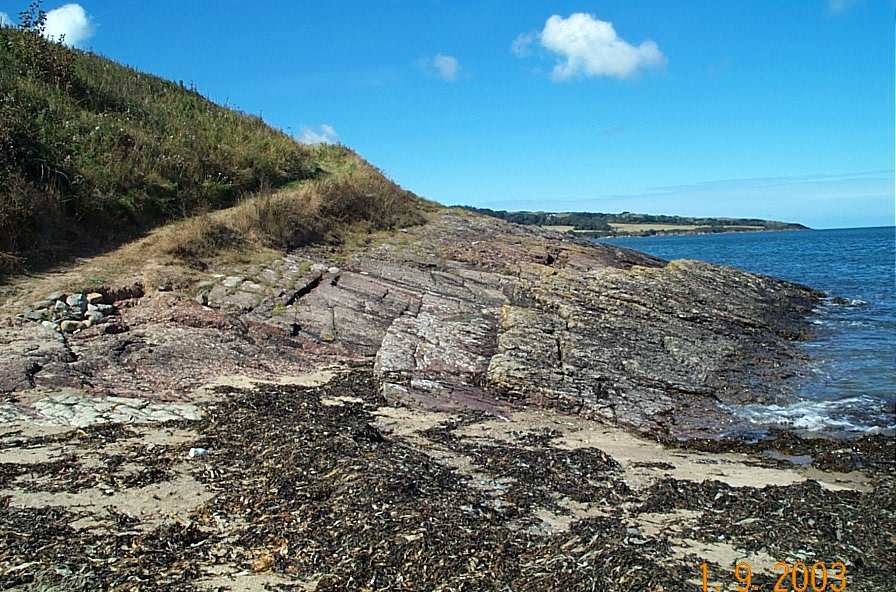
TRAETH
LLIGWY SITE OF SPECIAL SCIENTIFIC INTEREST
SITE MANAGEMENT STATEMENT
|
|
|
What is ‘special’ about the geology at Traeth Lligwy SSSI?
Traeth Lligwy SSSI has three special features:
Non-Marine Devonian rocks exposed in coastal cliffs and on the foreshore.
These red/purple sandstones allow geologists to reconstruct environmental conditions to show that the original sediments were deposited by meandering rivers some 400 million years ago.
Caledonian structures (folds and fractures) in coastal cliffs and on the foreshore.
These folds and fractures are associated with a period of mountain building (the Caledonian Orogeny) that occurred in Wales between 410-370 million years ago. However, these rocks were not deformed by a younger mountain building event, which affected southern Wales, and therefore geologists can study structures associated with the Caledonian Orogeny without the complication of later deformation
Lower Carboniferous rocks exposed in coastal cliffs and on the foreshore.
The limestones and shales at the eastern end of the bay are Lower Carboniferous in age, which enable geologists to reconstruct environmental conditions that existed in North Wales approximately 360 million years ago.
As well as the features listed above, Traeth Lligwy has other features that contribute to the special interest. These include inter-tidal rockpools, coastal grassland and scrub.
This mixture of habitats is generally important for wildlife. Unless specified below, management of this site should aim to look after these habitats and species as well as the listed features of interest.
The geological exposures should remain visible and accessible in order to allow further study and research. This will be achieved by avoiding activities which would diminish the current high level and continuity of exposure so that these rocks can be accessed when required for scientific purposes.
What management is needed on Traeth Lligwy SSSI and why?
Traeth Lligwy is an excellent place for geological study and sites such as this are vital for further geological research. However it will only remain so if the necessary management continues and CCW’s aim is to work with you to ensure that this management is carried out.
What does this mean in practice?
There are a number of different factors that could damage the special feature at Traeth Lligwy SSSI if they are not properly managed. These are the ones we regard as most important:
Ensuring visibility
Engineering works that would obscure the rock exposures, for example construction of steps to the beach or sewage pipes, may be damaging to the site interest. Similarly, the deposition of soil, rock or other material to strengthen shore defences may obscure the rocks. Any works that are required should be discussed with the Countryside Council for Wales to ensure that there is no damage to the site interest.
Maintaining natural coastal processes
The continued operation of natural coastal processes, in particular wave-action and sediment transport, which act to keep the sections clear of debris and accessible for study, are of vital importance at this site. We will want to ensure that these processes are not interrupted through, for example, the installation of groynes, sea defence wall, banks, barriers or similar structures constructed onshore or offshore, which have the effect of deflecting wave energy.
Accessibility
Students and researchers need access to study the rocks exposed at Traeth Lligwy. Public access to the beach and foreshore should be maintained.
Finally
Our knowledge of geology is continually improving and sites such as this are vital in that process. It is possible that new issues may arise in the future, whilst other issues may disappear. This statement is written with the best information we have now, but may have to change in the future as our understanding improves. Any information you can provide on the special feature of your site and its conservation would be much appreciated.
If you would like to discuss any aspect of your SSSI, or have any concerns about your SSSI, please contact your local CCW office.
Your local office is;
Cyngor Cefn Gwlad Cymru/Countryside Council for Wales
Llys y Bont,
Ffordd y Parc,
Parc Menai,
Bangor,
Gwynedd, LL57 4BN,
Fax: 01248 679259